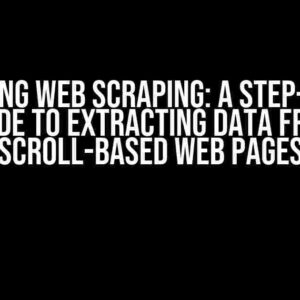Are you tired of having your Flowbite drawer pop up as soon as your page loads, annoying your users and disrupting their experience? Do you want to provide a seamless and controlled interaction with your drawer, only revealing it when users explicitly ask for it? Look no further! In this comprehensive guide, we’ll take you by the hand and walk you through the process of hiding your Flowbite drawer on page load and only showing it when users click the button.
Understanding the Problem
By default, Flowbite drawers are designed to be visible upon page load, which can be distracting and intrusive. This behavior might be suitable for some use cases, but for many others, it’s essential to provide more control over when the drawer appears. Perhaps you want to prioritize your main content, reduce clutter, or simply create a more gentle user experience.
Why Hide the Drawer on Page Load?
There are several compelling reasons to hide your Flowbite drawer on page load and only show it on demand:
- Improved User Experience**: By hiding the drawer, you can prioritize your main content and reduce distractions, allowing users to focus on what matters most.
- Increased Accessibility**: For users with disabilities, a sudden appearance of a drawer can be overwhelming or even cause confusion. By hiding it, you’re providing a more inclusive experience.
- Enhanced Aesthetics**: A clean and clutter-free design can greatly enhance the overall visual appeal of your website or application.
Solution Overview
To achieve our goal, we’ll use a combination of HTML, CSS, and JavaScript. We’ll add a button to trigger the drawer’s appearance, and then use JavaScript to toggle the drawer’s visibility on click. Finally, we’ll use CSS to style the drawer and ensure it’s hidden on page load.
Step 1: Add the Button and Drawer HTML
First, let’s add the necessary HTML elements to our page:
<button id="drawer-toggle">Toggle Drawer</button> <div id="drawer" class="flowbite-drawer"> <!-- Drawer content goes here --> </div>
In this example, we’ve added a button with an ID of “drawer-toggle” and a div with an ID of “drawer” and a class of “flowbite-drawer”. This will be our drawer container.
Step 2: Add JavaScript to Toggle the Drawer
Next, we’ll add the JavaScript code to toggle the drawer’s visibility on button click:
<script>
const drawerToggle = document.getElementById("drawer-toggle");
const drawer = document.getElementById("drawer");
drawerToggle.addEventListener("click", () => {
drawer.classList.toggle("hidden");
});
</script>
In this code, we’re selecting the button and drawer elements using `document.getElementById`. We then add an event listener to the button, which toggles the “hidden” class on the drawer element when clicked.
Step 3: Add CSS to Style and Hide the Drawer
Finally, we’ll add the CSS code to style the drawer and ensure it’s hidden on page load:
<style>
.flowbite-drawer {
position: fixed;
top: 0;
right: 0;
bottom: 0;
width: 300px;
background-color: #fff;
box-shadow: 0 0 10px rgba(0, 0, 0, 0.2);
transition: transform 0.3s;
}
.flowbite-drawer.hidden {
transform: translateX(100%);
}
.flowbite-drawer:not(.hidden) {
transform: translateX(0);
}
</style>
In this CSS code, we’re styling the drawer with a fixed position, dimensions, and a background color. We’re also adding a transition effect to smoothly slide the drawer in and out of view.
The `.hidden` class is used to hide the drawer on page load by translating it off-screen to the right. When the button is clicked, the `.hidden` class is toggled, and the drawer slides back into view.
Putting it All Together
Now that we’ve added the necessary HTML, JavaScript, and CSS, let’s see the final result:
<button id="drawer-toggle">Toggle Drawer</button>
<div id="drawer" class="flowbite-drawer hidden">
<!-- Drawer content goes here -->
</div>
<script>
const drawerToggle = document.getElementById("drawer-toggle");
const drawer = document.getElementById("drawer");
drawerToggle.addEventListener("click", () => {
drawer.classList.toggle("hidden");
});
</script>
<style>
.flowbite-drawer {
position: fixed;
top: 0;
right: 0;
bottom: 0;
width: 300px;
background-color: #fff;
box-shadow: 0 0 10px rgba(0, 0, 0, 0.2);
transition: transform 0.3s;
}
.flowbite-drawer.hidden {
transform: translateX(100%);
}
.flowbite-drawer:not(.hidden) {
transform: translateX(0);
}
</style>
With this code, your Flowbite drawer will now be hidden on page load and only appear when users click the toggle button.
Troubleshooting and Customization
If you encounter any issues with the implementation, here are some troubleshooting tips:
- Check the JavaScript console for errors**: Make sure there are no JavaScript errors preventing the toggle functionality from working.
- Verify the CSS styles are being applied**: Ensure that the CSS styles are being applied to the drawer element and that there are no conflicts with other styles.
- Adjust the CSS transitions and animations**: If you encounter issues with the transition effect, try adjusting the animation duration or timing function.
For further customization, you can modify the CSS styles to fit your specific design requirements. You can also experiment with different JavaScript libraries or frameworks to enhance the toggle functionality.
Conclusion
In this comprehensive guide, we’ve demonstrated how to hide a Flowbite drawer on page load and only show it when users click a toggle button. By following these steps, you can provide a more controlled and user-friendly experience for your website or application visitors. Remember to customize the code to fit your specific needs and don’t hesitate to reach out if you encounter any issues.
| Drawer State | Class Applied | Description |
|---|---|---|
| Hidden | .hidden | The drawer is hidden and translated off-screen to the right. |
| Visible | :not(.hidden) | The drawer is visible and translated back into view. |
By mastering this technique, you’ll be able to create a more seamless and engaging user experience for your audience. Happy coding!
Frequently Asked Question
Got stuck with Flowbite drawer? Don’t worry, we’ve got you covered! Here are some frequently asked questions and answers to help you hide the Flowbite drawer when the page loads and only show it when users click the button.
How do I hide the Flowbite drawer on page load?
Easy peasy! You can add the ‘hidden’ class to the drawer container element. For example, `
`. This will hide the drawer by default when the page loads.
How do I show the Flowbite drawer when the button is clicked?
Simple! You can add a JavaScript event listener to the button that toggles the ‘hidden’ class on the drawer container element. For example, ``. This will show the drawer when the button is clicked.
Can I use CSS to hide and show the Flowbite drawer?
Absolutely! You can use CSS to hide and show the drawer by adding a CSS class to the drawer container element. For example, `.drawer { display: none; }` to hide the drawer, and then use JavaScript to toggle this class when the button is clicked. Or, you can use the `:hidden` pseudo-class to select the drawer element and style it accordingly.
How do I make sure the Flowbite drawer is accessible for screen readers?
Great question! To make the Flowbite drawer accessible for screen readers, you should add an `aria-hidden` attribute to the drawer container element and set it to `true` when the drawer is hidden. Then, toggle this attribute to `false` when the drawer is shown. This will ensure that screen readers announce the presence or absence of the drawer correctly.
Can I animate the Flowbite drawer when it’s shown or hidden?
Why not?! You can add CSS transitions or animations to the drawer container element to create a smooth and visually appealing effect when the drawer is shown or hidden. For example, you can use `transition: opacity 0.5s` to fade the drawer in and out, or use a more complex animation library like AnimeJS to create a custom animation.



